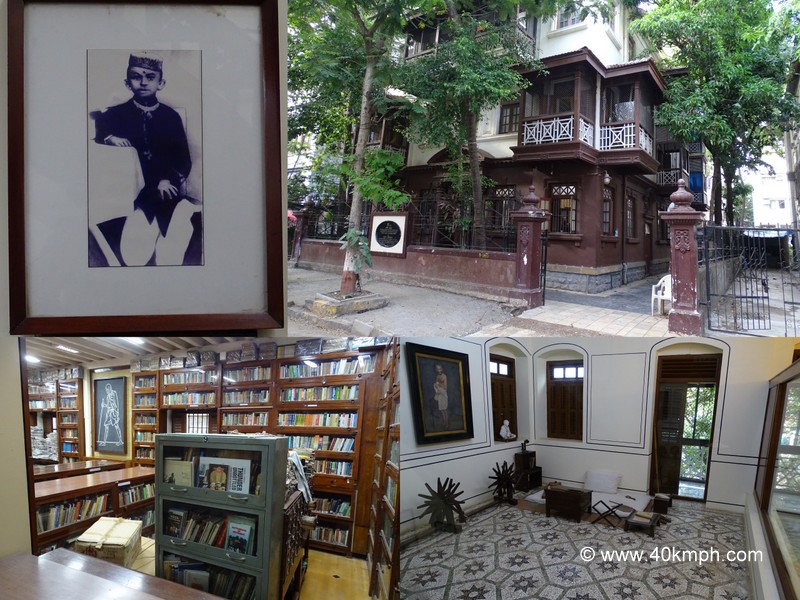The visit to Mani Bhavan in Mumbai was the second one. This time I reached via Mumbai local train. The nearest railway station is Grant Road. After reaching Grant Road I walk towards the West side to climb the skywalk to walk a few meters till I reach – the stairs towards Chowpatty. Once on the road, I walk near Gamdevi Police Station (Estd. 1917) on the right side, and second right turn inside a lane I reach Mani Bhavan situated on the right side.
If you are coming via Chowpatty, get down near Wilson College red light. Enter the road adjacent to the college. Cross two red lights. The second left turn is Mani Bhavan situated on the right side.
Mani Bhavan is a famous two-story building that was the residence of Shri Revashankar Jagjivan Jhaveri, who was host to Gandhi ji during his visits to Mumbai from 1917 to 1934. In 1955 the building was dedicated as a memorial to Gandhi ji.
Mani Bhavan is recognized as a Research Institute in Gandhian Thought and Rural Development by Mumbai University.
Highlights of Mani Bhavan
- Gandhi Ji took his first lessons in carding here only from a carder who used to pass by Mani Bhavan every day in 1917. He also learned spinning here. He also had goat’s milk here when his health was very critical in January 1919.
- Call for Satyagraha against Rowlett Act in March 1919 was given from Mani Bhavan.
- While staying in Mani Bhavan Gandhi Ji lent support to Khilafat Agitation in 1920.
- Gandhi Ji organized a boycott and bonfires of foreign cloth from here only on July 31, 1921.
- The Congress Working Committee met here on June 9, 1931, and decided to send Gandhi Ji as the sole representative of the Congress to the Round Table Conference in London.
- The launch of Civil Disobedience or Swaraj was done at midnight on December 31, 1931.
- 4th January 1932 Gandhi Ji was arrested from here.
- Prominent political leaders visited Mani Bhavan for consultations with Gandhi Ji.
And many many more…
Mani Bhavan is a wonderful museum to learn about the Father of The Nation, the Independence struggle, letters, quotes by Mahatma, and his thoughts via a picture gallery well displayed on walls.
Highlights of Picture Gallery
- Gandhi Ji 7 years old photo.
- Evolution in Gandhi Ji’s dress from 1917 to 1934.
- Gandhi Ji’s photo taken in the year 1886 with his brother Laxmidas.
- Gandhi Ji as a volunteer of the Indian Ambulance Corps, 1899, South Africa.
- Gandhi Ji as a Law student in London, 1888-1891
- Gandhi Ji as a leader of Indian Stretcher-Bearer Corps, South Africa – 1906.
- Gandhi ceremoniously broke the Salt Law by picking up a lump of natural salt, Dandhi April 6, 1930
- The passport was issues to Gandhiji to attend Round Table Conference on 28 August 1931.
- Gandhi-Tolstoy correspondence 1909-1910.
- His letters to Hitler and President Roosevelt is also there.
- Mahatma photos with prominent political leaders and personalities such as Jawaharlal Nehru, Rabindranath Tagore, Maulana Abdul Kalam Azad, Subash Chandra Bose, Pandit Madan Mohan Malviya, Gopal Krishna Gokhale, Sarojini Naidu, Charlie Chaplin.
And many many more…
To Gandhi, spinning was a sacrament. He felt that every time he drew a thread on the wheel, he was coming nearer to the poorest of the poor and through them to God.
Gandhi Ji said in June 1930 – “Shrimad Rajchandra captivated my heart in religious matters as no other man has till now.”
Other than the above said, on the first floor is the auditorium where films on Gandhi Ji are shown including recordings of his speeches. The second floor is also about a collection of clay models depicting various scenes of India’s movement for Independence. There are 28 tableaux depicting Gandhi Ji’s life through mini-figures prepared by Smt. Susheela Gokhale Patel.
Gandhi Ji’s room is on the 2nd floor which used to be the living room and working place of Gandhi ji.
No Entry fees
Timings / Visiting Hours: 9:30 – 6:00 (365 days open)
A library is at the ground floor consists of more than 50,000 books.
The library is closed on the second and fourth Saturdays including Holidays but the museum is open 365 days.
Mani Bhavan in Mumbai is a must-visit museum because it is one of the most important Gandhi Memorial Museums in India. During the visit, I purchased a CD – “Sabarmati Ke Sur – Bapu’s favorite hymns” for Rs. 200.
Do you know – While writing when Gandhiji’s right hand was exhausted, he wrote with his left hand.
